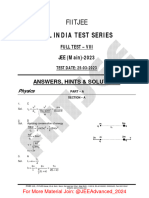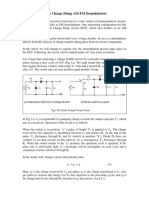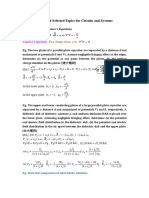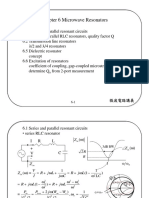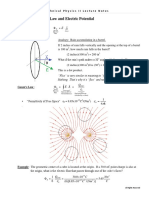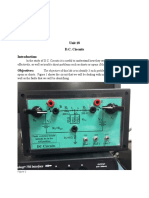Lecture 4: Electric Potential/Voltage (Cont.) and Capacitors
Lecture 4: Electric Potential/Voltage (Cont.) and Capacitors
Uploaded by
Amir YonanCopyright:
Available Formats
Lecture 4: Electric Potential/Voltage (Cont.) and Capacitors
Lecture 4: Electric Potential/Voltage (Cont.) and Capacitors
Uploaded by
Amir YonanOriginal Description:
Original Title
Copyright
Available Formats
Share this document
Did you find this document useful?
Is this content inappropriate?
Copyright:
Available Formats
Lecture 4: Electric Potential/Voltage (Cont.) and Capacitors
Lecture 4: Electric Potential/Voltage (Cont.) and Capacitors
Uploaded by
Amir YonanCopyright:
Available Formats
13 | S p u r l o c k ’ s T e c h n i c a l P h y s i c s I I L e c t u r e N o t e s
Lecture 4: Electric Potential/Voltage (Cont.) and Capacitors
Pfinal
Determining V From E: dV E dl V dl
E
Pinit
Q
For a Point Charge: VPoint Charge k
r
Pfinal
rb
rb
Q Q Q
• V E dl E dr k 2 dr k k
Pinit ra ra
r rb ra
Q
• To fix a reference, we set V=0 at r→ VPoint Charge k
r
• V is a scalar (we aren’t finding magnitudes) Keep the signs on the charges.
• Superposition: Just add up V for multiple charges/sources.
Example: What is the potential at the point (2.25 m, 1.50 m) measured with respect to the origin in a
region with a uniform electric field E = (4.00 N/C)î + (2.00 N/C)ĵ ?
Pfinal
Pfinal
V E dl E dl E l
Pinit Pinit
(4.00 N/C)î (2.00 N/C)ĵ (2.25m) î (1.50m) ĵ
(4.00 N/C)(2.25m) (2.00 N/C)(1.50m) 12.0V
Example: Determine the electric potential at the point P due to the 3 point charges
Q1 Q Q Q Q Q
VTOT V1 V2 V3 k k 2 k 3 k 1 2 3
r1 r2 r3 r1 r2 r3
16.0 106 C 20.0 106 C 12.0 106 C
VTOT (9.00 10 Nm / C )
9 2 2
360kV
0.400m 0.500m 0.300m
All Rights Reserved
14 | S p u r l o c k ’ s T e c h n i c a l P h y s i c s I I L e c t u r e N o t e s
Example: A thin flat disk of radius R0 has a uniformly distributed charge Q. Determine the potential at
a point P on the axis of the disk, a distance x from the center.
dQ dQ
dV k V dV k
r r
What variable do we integrate over? R (not r)
Q 2Q
dQ dA 2 2R dR 2 RdR
R0 R0
dQ 2kQ RdR 2kQ RdR
dV k 2 2
r R0 r R0 R x
2 2
Can we just integrate dV? Yes! dV is a scalar!
2kQ 0 RdR
R
V dV 2
R0 0 R x
2 2
2 2 1/ 2 1 2 2 1 / 2
U [R x ] dU [R x ] 2 RdR
2
2kQ 0 2kQ R R 2kQ
2kQ
R
R R0
V 2 dU 2 U R 0 0 2 R 2 x 2 R 0 2 R02 x 2 x
R0 0 R0 R0 R0
E from V
V
• dV E dl El
l
V V V
• Ex , Ey , Ez
x y z
Example: In a certain region of space the electric potential is given by V(x,y,z) = y2 + 2.5xy – 3.5xyz.
Determine the electric field.
V
Ex 2.5 y 3.5 yz 3.5 yz 2.5 y
x
V
Ey 2 y 2.5 x 3.5 xz 3.5 xz 2.5 x 2 y
y
V
Ez 3.5xy 3.5xy
z
E (3.5 yz 2.5 y )iˆ (3.5 xz 2.5 x 2 y ) ˆj (3.5 xy )kˆ
All Rights Reserved
15 | S p u r l o c k ’ s T e c h n i c a l P h y s i c s I I L e c t u r e N o t e s
Equipotential Surfaces (Every point in the surface is at the same potential)
• No work is done by electrical forces when moving along an equipotential surface.
• The electric field is always to the equipotential surface.
Roadmap
Capacitance: Q CV
• Q = Charge
• C = Capacitance
• V = Electric Potential
•
• Units: Farad 1 F = 1 C/V
•
Parallel Plate Capacitor
Q
Electric field at surface of conductor: E
0 0 A
E is constant.
Qd d A 0 A
V E d Ed Q Q 0 V CV C
0 A 0 A d d
All Rights Reserved
16 | S p u r l o c k ’ s T e c h n i c a l P h y s i c s I I L e c t u r e N o t e s
Dielectrics: A dielectric is an insulating material placed between the capacitor plates.
k = “dielectric constant” E is constant.
0
1
C C0
0 0
A 0 A
C' C
d d
Example: What voltage is required to store 7.20x10-5C of charge on the plates of a 6.00μF capacitor?
Q 7.20 10 5 C
Q CV V 12.0 V
C 6.00 10 6 F
Example: A parallel plate capacitor has a capacitance of 7.00μF when filled with a dielectric. The area
of each plate is 1.50m2 and the separation between the plates is 1.00x10-5m. What is the
dielectric constant of the dielectric material?
0 A dC (1.00 105 m)(7.00 106 F )
C 5.3
d
0 A 8.85 1012 C 2 /( Nm 2 ) (1.50m2 )
All Rights Reserved
You might also like
- Capacitance of The P-N JunctionDocument22 pagesCapacitance of The P-N JunctionLeng RyanNo ratings yet
- Lecture - 13 Lecture - 13: EEN-206: Power Transmission and Distribution EEN-206: Power Transmission and DistributionDocument20 pagesLecture - 13 Lecture - 13: EEN-206: Power Transmission and Distribution EEN-206: Power Transmission and Distributionguddu guptaNo ratings yet
- P2213 Final S23 Formula SheetDocument3 pagesP2213 Final S23 Formula Sheethi hiNo ratings yet
- 1512 S17 E 1 FormulasDocument1 page1512 S17 E 1 FormulasSamuel Alfred ForemanNo ratings yet
- R L C V I R L C R L C I - T: G 2 S T D 2 SDocument1 pageR L C V I R L C R L C I - T: G 2 S T D 2 SBrijendra SinghNo ratings yet
- MOT 2 JEE 2021 Solutions PDFDocument16 pagesMOT 2 JEE 2021 Solutions PDFBiswadeep GiriNo ratings yet
- Physics 122B Electricity and MagnetismDocument26 pagesPhysics 122B Electricity and Magnetismbedjamkhed5010No ratings yet
- Final Step-B SolutionsDocument77 pagesFinal Step-B SolutionsHalfborn GundersonNo ratings yet
- Eee3352 L3Document34 pagesEee3352 L3Desmond CheweNo ratings yet
- Dielectric CapacitorDocument6 pagesDielectric CapacitorMAUSAM KatariyaNo ratings yet
- Aits 2223Document16 pagesAits 2223Nirbhik GuptaNo ratings yet
- Agn 2019Document4 pagesAgn 2019lidiNo ratings yet
- Transient Phenomena and AC CircuitDocument3 pagesTransient Phenomena and AC CircuitlavishashekhNo ratings yet
- (N) Other Image ProblemDocument2 pages(N) Other Image ProblemMohsin ZakiNo ratings yet
- Physics 132 Midterm II Equation Sheet: Capacitors, EnergyDocument1 pagePhysics 132 Midterm II Equation Sheet: Capacitors, Energysalmanfarce302No ratings yet
- FEE 422 Telecomms Exam - May 2016 - SolutionsDocument7 pagesFEE 422 Telecomms Exam - May 2016 - SolutionsJoshua MNo ratings yet
- Dokumen - Tips Commutation Techniques in Power ElectronicsDocument28 pagesDokumen - Tips Commutation Techniques in Power ElectronicsMeral MeralNo ratings yet
- Electricity Hong Kong NotesDocument114 pagesElectricity Hong Kong NotesArlin BirkbyNo ratings yet
- Fallsem2016-17 6988 RM001 11-Aug-2016 Ece1001 EthDocument23 pagesFallsem2016-17 6988 RM001 11-Aug-2016 Ece1001 EthGaurav AgarNo ratings yet
- Tangential FlowDocument4 pagesTangential FlowFernandoNo ratings yet
- Lect 4 ResonatorsDocument10 pagesLect 4 ResonatorsCyrille MagdiNo ratings yet
- Ioqp 2021 22 Part I SolutionDocument11 pagesIoqp 2021 22 Part I SolutionJyoti DhillonNo ratings yet
- Sensors: Read Chapter 2 of TextbookDocument102 pagesSensors: Read Chapter 2 of TextbookJanelle Gil MallariNo ratings yet
- 8 MicrostripsDocument6 pages8 MicrostripsBasheer Najem aldeenNo ratings yet
- PHYS 102 - General Physics II Final Exam Solutions: Duration: 120 Minutes Wednesday, 22 May 2019Document4 pagesPHYS 102 - General Physics II Final Exam Solutions: Duration: 120 Minutes Wednesday, 22 May 2019Serkan Doruk HazinedarNo ratings yet
- Shell Momentum Balance For PipeDocument12 pagesShell Momentum Balance For PipeTushar AgrawalNo ratings yet
- Current Electricity-09-Subjective and Objective SolutionsDocument26 pagesCurrent Electricity-09-Subjective and Objective SolutionsRaju SinghNo ratings yet
- JEST Physics ProblemsDocument38 pagesJEST Physics ProblemsPDP100% (2)
- AITS 2223 FT VIII JEEM SolDocument14 pagesAITS 2223 FT VIII JEEM Soltejash9960No ratings yet
- PHY - IIT ENTHUSE - PAPER-1 - RT-3 - Mrinal Sir - 18-06-23Document17 pagesPHY - IIT ENTHUSE - PAPER-1 - RT-3 - Mrinal Sir - 18-06-23Rajanikanta PriyadarshiNo ratings yet
- Charge Pump Am-Fm DemodulatorsDocument7 pagesCharge Pump Am-Fm DemodulatorsJeannot BopendaNo ratings yet
- Physics Advanced Level Problem Solving (ALPS-10) - SolutionDocument8 pagesPhysics Advanced Level Problem Solving (ALPS-10) - SolutionSwapnil MandalNo ratings yet
- Department of Electrical Engineering Indian Institute of Technology, Kanpur Esc 201 Home Assignment #13 Assigned: 25.10.18Document1 pageDepartment of Electrical Engineering Indian Institute of Technology, Kanpur Esc 201 Home Assignment #13 Assigned: 25.10.18Aditya TiwariNo ratings yet
- Adobe Scan 23-Nov-2022Document4 pagesAdobe Scan 23-Nov-2022SunnyNo ratings yet
- Classical Mechanics JEST 2012-2017 PDFDocument26 pagesClassical Mechanics JEST 2012-2017 PDFMainak Dutta100% (1)
- Chapter 8: Simple RC and RL CircuitsDocument39 pagesChapter 8: Simple RC and RL Circuitsdabs_orangejuiceNo ratings yet
- Elementi Elektronike - FEBRUAR 2017 - REŠENJA: I R R V V IDocument3 pagesElementi Elektronike - FEBRUAR 2017 - REŠENJA: I R R V V IФејсбук КорисникNo ratings yet
- Causes of Water Influx Relationship Between:: - A Well and Oil Reservoir. - Oil Reservoir and The AquiferDocument26 pagesCauses of Water Influx Relationship Between:: - A Well and Oil Reservoir. - Oil Reservoir and The AquiferAnonymous qaI31HNo ratings yet
- Chapter 4 Selected Topics For Circuits and Systems: Poission's Equation: Laplace's EquationDocument33 pagesChapter 4 Selected Topics For Circuits and Systems: Poission's Equation: Laplace's EquationArial96No ratings yet
- AC Current & Semiconductors: L5 by Ahmed AtlamDocument23 pagesAC Current & Semiconductors: L5 by Ahmed AtlamAhmed AtlamNo ratings yet
- Lec 6 - Electrostatic FieldDocument28 pagesLec 6 - Electrostatic FieldBeat FreakNo ratings yet
- Prob3 19sDocument3 pagesProb3 19scucabeludoNo ratings yet
- Adobe Scan 02 May 2023Document4 pagesAdobe Scan 02 May 2023vigneshmatta2004No ratings yet
- Ch4 Basic Vortex DynamicsDocument25 pagesCh4 Basic Vortex Dynamicsd92543013100% (1)
- Physics Advanced Level Problem Solving (ALPS-1) - SolutionDocument16 pagesPhysics Advanced Level Problem Solving (ALPS-1) - SolutionIshan AgnohotriNo ratings yet
- Electric Potential IDocument22 pagesElectric Potential IFARHEEN FATIMANo ratings yet
- Physics 210 Equations: QQ F Q F K R E E K R R Q R PeDocument2 pagesPhysics 210 Equations: QQ F Q F K R E E K R R Q R PementeNo ratings yet
- R Q Q Q A +Q: Jitender SinghDocument3 pagesR Q Q Q A +Q: Jitender SinghSophieNo ratings yet
- R R R V: Department of Avionics, Indian Institute of Space Science & Technology, TrivandrumDocument6 pagesR R R V: Department of Avionics, Indian Institute of Space Science & Technology, Trivandrumaditya narayan shuklaNo ratings yet
- Aerodyn2 Discussion 8 Climb Performance and Speed Propeller DrivenDocument11 pagesAerodyn2 Discussion 8 Climb Performance and Speed Propeller DrivenCapNo ratings yet
- Eeen 301 Lecture IiDocument23 pagesEeen 301 Lecture IiKabiru FaisalNo ratings yet
- Tunnel Diodes Tunnel DiodesDocument15 pagesTunnel Diodes Tunnel DiodesMahy MagdyNo ratings yet
- L3 Electric PotentialDocument22 pagesL3 Electric PotentialBakhat BaidarNo ratings yet
- Hukum Coulomb Dan Medan ListrikDocument66 pagesHukum Coulomb Dan Medan Listrikdavid purbaNo ratings yet
- Root-Mean-Square Value: I. Complete Sinusoidal WaveformDocument3 pagesRoot-Mean-Square Value: I. Complete Sinusoidal WaveformSuhaib_Faryad_5001No ratings yet
- PDF - Microwave ResonatorsDocument22 pagesPDF - Microwave ResonatorsAmali JayawardhanaNo ratings yet
- PHYS 102 - General Physics II Midterm Exam 2 Solutions: V V P R R PDocument2 pagesPHYS 102 - General Physics II Midterm Exam 2 Solutions: V V P R R PNano SuyatnoNo ratings yet
- The Spectral Theory of Toeplitz Operators. (AM-99), Volume 99From EverandThe Spectral Theory of Toeplitz Operators. (AM-99), Volume 99No ratings yet
- Feynman Lectures Simplified 2C: Electromagnetism: in Relativity & in Dense MatterFrom EverandFeynman Lectures Simplified 2C: Electromagnetism: in Relativity & in Dense MatterNo ratings yet
- Lecture 6: Circuits (Cont.), Kirchoff's Laws, and Nodal AnalysisDocument8 pagesLecture 6: Circuits (Cont.), Kirchoff's Laws, and Nodal AnalysisAmir YonanNo ratings yet
- Lecture 3: Gauss's Law and Electric PotentialDocument3 pagesLecture 3: Gauss's Law and Electric PotentialAmir YonanNo ratings yet
- Lecture 5: Capacitors (Cont.), Circuits, Current, and ResistanceDocument6 pagesLecture 5: Capacitors (Cont.), Circuits, Current, and ResistanceAmir YonanNo ratings yet
- 1444 Unit 18 Lab ReportDocument13 pages1444 Unit 18 Lab ReportAmir YonanNo ratings yet
- BR Unit 21Document8 pagesBR Unit 21Amir YonanNo ratings yet
- Unit 21 - Series AC CircuitsDocument5 pagesUnit 21 - Series AC CircuitsAmir YonanNo ratings yet
- Lab 4Document7 pagesLab 4Amir YonanNo ratings yet
- HW 8 SolDocument24 pagesHW 8 SolAmir YonanNo ratings yet
- EMR Ranking & Calculation (Two Questions On Exam) - : Easy/mediumDocument12 pagesEMR Ranking & Calculation (Two Questions On Exam) - : Easy/mediumItzel NavaNo ratings yet
- (Download PDF) Bose Einstein Condensation and Superfluidity 1St Edition Pitaevski Online Ebook All Chapter PDFDocument42 pages(Download PDF) Bose Einstein Condensation and Superfluidity 1St Edition Pitaevski Online Ebook All Chapter PDFshalonda.burks605100% (14)
- Beg 2105 Physical Electronics I - 1 IntroDocument166 pagesBeg 2105 Physical Electronics I - 1 IntroElias keNo ratings yet
- DT & NDTDocument46 pagesDT & NDTThulasi Ram100% (1)
- Antenna Basics: Kraus-38096 Book October 10, 2001 13:3Document46 pagesAntenna Basics: Kraus-38096 Book October 10, 2001 13:3Zar KhitabNo ratings yet
- Quantum Physics For Beginners - Steven N. FulmerDocument123 pagesQuantum Physics For Beginners - Steven N. FulmerRon FarnsworthNo ratings yet
- Stamford Alternator Technical Data Sheet of Generator HCM5D-311-TD-EN Rev ADocument9 pagesStamford Alternator Technical Data Sheet of Generator HCM5D-311-TD-EN Rev ADanial AbdullahNo ratings yet
- Topic 3 Electric Charge: 1. Electric Charge Read The Passage and Answer The Questions!Document6 pagesTopic 3 Electric Charge: 1. Electric Charge Read The Passage and Answer The Questions!FarhnsNo ratings yet
- Study Journal Lesson 23-32 - LisondraDocument3 pagesStudy Journal Lesson 23-32 - Lisondrasenior highNo ratings yet
- Operating Instruction Manual FOR Multi-Unit Case: 590-04W/590-04R 590-06W/590-06R 590-09W/590-09R 590-12W/590-12RDocument20 pagesOperating Instruction Manual FOR Multi-Unit Case: 590-04W/590-04R 590-06W/590-06R 590-09W/590-09R 590-12W/590-12RМаксNo ratings yet
- Umeb-S.A Three-Phase Squirrel Cage Non-Sparking Induction Motors Ex Na II T4 Type ASNA 100la-4 2.2 KW, 1500 Rot/minDocument4 pagesUmeb-S.A Three-Phase Squirrel Cage Non-Sparking Induction Motors Ex Na II T4 Type ASNA 100la-4 2.2 KW, 1500 Rot/minCARMEN DIMITRIUNo ratings yet
- Engineering Physics Optics MainDocument87 pagesEngineering Physics Optics MainHasan ZiauddinNo ratings yet
- HoDocument2 pagesHoLasmaenita SiahaanNo ratings yet
- APMDocument12 pagesAPMGuadalajara JaliscoNo ratings yet
- NJR2 Soft Starter ChinDocument5 pagesNJR2 Soft Starter ChinJessy Marcelo Gutierrez ChuraNo ratings yet
- Nepal Electricity AthorityDocument22 pagesNepal Electricity AthorityShubham BaderiyaNo ratings yet
- 424 60Document76 pages424 60Mourad BenderradjiNo ratings yet
- Table 9 Alternating-Current Resistance and Reactance For 600-Volt Cables, 3-Phase, 60 HZ, 75°C (167°F) - Three Single Conductors in ConduitDocument1 pageTable 9 Alternating-Current Resistance and Reactance For 600-Volt Cables, 3-Phase, 60 HZ, 75°C (167°F) - Three Single Conductors in ConduitPaul BautistaNo ratings yet
- General - Overview - Part2 - Safety Stanadard Lithium ComparsionDocument3 pagesGeneral - Overview - Part2 - Safety Stanadard Lithium ComparsionDeepak GehlotNo ratings yet
- Electromagnetic Fields & Waves (BEB20303) Chapter 1: Electrostatic FieldDocument32 pagesElectromagnetic Fields & Waves (BEB20303) Chapter 1: Electrostatic FieldAFiqah Nazirah JailaniNo ratings yet
- Impedance MeasurementDocument7 pagesImpedance MeasurementBenita GeolinNo ratings yet
- Technical Application Guide BackLED and BoxLED Portfolio (En)Document28 pagesTechnical Application Guide BackLED and BoxLED Portfolio (En)vbgiriNo ratings yet
- Wattmeter Solved PRoblems-Paliza, JoshuaDocument11 pagesWattmeter Solved PRoblems-Paliza, Joshuajoshua palizaNo ratings yet
- 44 Government Documents Prove Flat EarthDocument46 pages44 Government Documents Prove Flat EarthSávio MaffiolettiNo ratings yet
- Y.XMB 225: Mobile X-Ray SystemDocument2 pagesY.XMB 225: Mobile X-Ray Systemsaeed sedghiNo ratings yet
- ABB HD4 Circuit Breaker BrochureDocument60 pagesABB HD4 Circuit Breaker BrochureSMC QuasarNo ratings yet
- Chapter Summary Physics Term 2Document7 pagesChapter Summary Physics Term 2Rashed AlawaishehNo ratings yet
- Non - Degenerate PerturbationsDocument2 pagesNon - Degenerate PerturbationsnithinNo ratings yet
- Free Electron TheoryDocument4 pagesFree Electron TheoryARGHYADEEP NAGNo ratings yet
- Overhead - Line Data SheetDocument114 pagesOverhead - Line Data SheetTasneem El-amin BabikirNo ratings yet




























